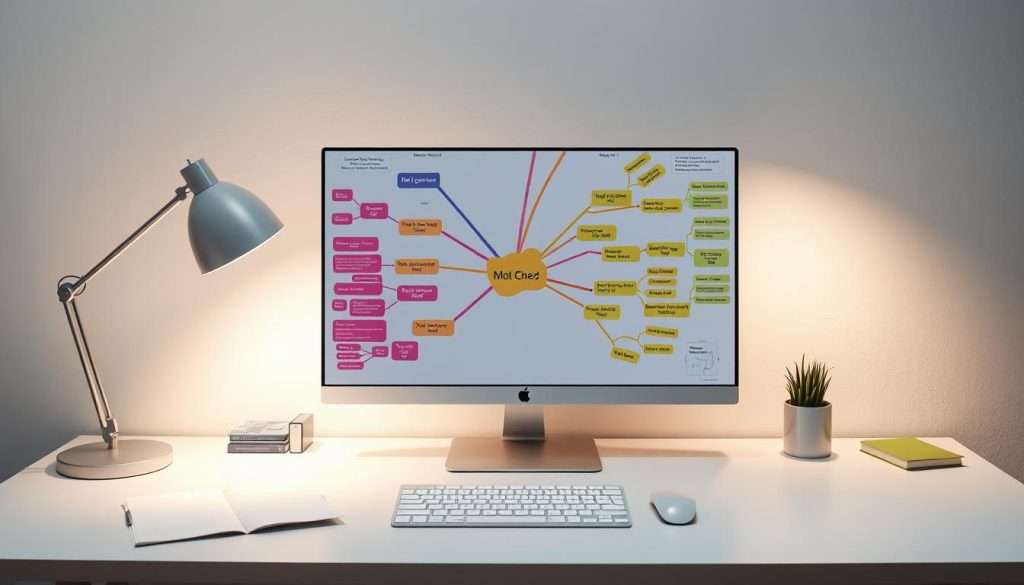Are you tired of studying for hours without seeing results? You’re not alone! Many students feel stuck in a cycle of cramming and forgetting. This leaves them feeling frustrated and demotivated.
Effective learning strategies can change everything. By studying smarter, not harder, you can get better grades. Our 7-day smart study plan helps you do this without losing your sanity or social life. It’s a real solution for when you’re tired, distracted, or lack the perfect routine.
We’re here to show you that smart study habits lead to better results. We’re excited to share our insights with you.
Key Takeaways
- Discover how to study more efficiently, not just harder.
- Learn effective learning strategies that work for you.
- Develop a personalized study plan that fits your lifestyle.
- Improve your grades without sacrificing your well-being.
- Stay motivated and focused with our practical tips.
The Problem with Traditional Study Methods
How we study is just as crucial as what we study. Many students fall into bad habits. We’ve all been there – stuck in long study sessions, feeling overwhelmed and unsure if we can remember what we’ve learned.
Why Cramming and All-Nighters Fail
Cramming and all-nighters might seem like a must, but they’re not good. Studies show sleep loss hurts our brains, making it tough to remember things and do well on tests. Pulling an all-nighter is as bad as being drunk with a blood alcohol level of 0.1% – that’s legally drunk!
The Diminishing Returns of Long Study Sessions
Long study sessions without breaks don’t help much. Our brains can only stay focused for so long before getting tired. Think of it like a computer processor – the more tasks it handles, the slower it gets.
Common Signs You’re Studying Inefficiently
| Signs | Symptoms | Solutions |
|---|---|---|
| Feeling overwhelmed | Struggling to understand material, frequent anxiety | Break study sessions into manageable chunks |
| Poor retention | Forgetting key concepts shortly after studying | Implement spaced repetition and active recall |
| Lack of focus | Frequent distractions, difficulty staying on task | Use the Pomodoro Technique to boost concentration |
By spotting these signs and changing our study habits, we can learn more with less effort. It’s time to ditch old ways and find better, more effective ways to learn.
The Science Behind Efficient Learning
Learning efficiently means knowing how our brains handle information. By understanding this, we can study better.
How Your Brain Processes and Retains Information
Our brains process info in specific ways. New info goes to short-term memory first. To keep it, we move it to long-term memory through repetition and practice. Knowing this helps us use better retention techniques.
The Forgetting Curve and Optimal Review Timing
The forgetting curve shows how we forget new info over time. Reviewing at the right times can fight this. This means using spaced repetition, reviewing just before forgetting.
Neuroplasticity: Training Your Brain to Learn Faster
Neuroplasticity is our brain’s ability to change. By learning new things, we get better at learning. This is key for improving learning efficiency.
| Technique | Description | Benefit |
|---|---|---|
| Spaced Repetition | Reviewing material at increasingly longer intervals | Enhances long-term retention |
| Active Recall | Actively recalling information from memory | Strengthens memory and understanding |
| Chunking | Breaking down information into smaller chunks | Improves organization and comprehension |
Using these effective learning strategies makes studying more effective. We can reach our learning goals faster.
From Hustling to Mastering: How Smart Students Study Less and Learn More
Smart students don’t study harder; they study smarter. They get more done with less effort. It’s about learning better, not just longer.
Shifting from Time-Based to Results-Based Learning
Traditional studying looks at how long you study, not what you achieve. To really master your studies, focus on the results. Set clear goals and track your progress.
For example, instead of studying for three hours straight, try the Pomodoro Technique. Study for 25 minutes, then take a 5-minute break. This method helps you stay focused and remember more.
The 80/20 Principle Applied to Studying
The 80/20 principle says 80% of results come from 20% of efforts. In studying, it means focusing on the most important topics first. This way, you get the most out of your study time.
Emily, a college student, applied this principle and cut her study time by 30%. Her grades went up too.
David, a high school student, used the Pomodoro Technique. He noticed big improvements in his understanding and retention.
By using these strategies, you can study less and learn more. It’s about being smart, not just working hard.
Strategic Time Management for Maximum Learning
Effective time management is key to learning well. We’ll explore strategies that help. As students, managing your time well can change how you feel and achieve your goals.
Implementing the Pomodoro Technique for Deep Focus
The Pomodoro Technique is a big help for staying focused. It uses 25-minute focused intervals (called “Pomodoros”) with 5-minute breaks in between. After four cycles, take a longer break of 15-30 minutes. It keeps you on track and prevents burnout.
To use this technique, pick a task, set a timer, and work without interruptions until it goes off. Use a planner, digital calendar, or apps like Pomodoro Timer to track your sessions.
Time Blocking: Creating Your Optimal Study Schedule
Time blocking means setting study sessions in fixed, uninterrupted blocks. It helps you focus and manage your time better. To make your best study schedule:
- Find your most productive hours.
- Block out study time, avoiding distractions.
- Take breaks between blocks to recharge.
Batching Similar Subjects for Cognitive Efficiency
Grouping similar subjects together boosts your brain power. Focusing on one type of material or task reduces switching costs. For example, set aside days for specific subjects or group similar tasks like problem-solving or reading.
Using these time management tips will boost your productivity and learning. The aim is to study smarter, not harder.
Active Learning Techniques That Double Retention
Active learning is more than just a trend; it’s a key to better retention and success in studies. It involves more than just reading or listening. You actively participate in the learning process. This makes learning fun and boosts your ability to remember information.
Mastering the Feynman Technique Step-by-Step
The Feynman Technique is a powerful tool for learning. It’s named after Richard Feynman and helps explain complex ideas simply. Here’s how to use it:
- Choose a concept you want to learn about.
- Explain it as if teaching it to a child.
- Identify gaps in your explanation and fill them.
- Simplify your language and repeat the process.
Practice Exercise: Explaining Complex Concepts Simply
Now, let’s practice the Feynman Technique. Pick a complex topic and explain it to someone who knows nothing about it. Use simple words and examples. This exercise helps you understand and communicate complex ideas better.
Retrieval Practice: Creating Effective Self-Tests
Retrieval practice is another great strategy. Instead of just re-reading your notes, try to recall the information. Make flashcards or take quizzes to test your knowledge. This strengthens your memory and helps you retain information longer.
Implementing Spaced Repetition Systems
Spaced repetition reviews material at longer intervals to solidify it in your memory. Use apps or flashcards that follow this system. It makes your study sessions more effective and helps you remember better.
| Technique | Description | Benefits |
|---|---|---|
| Feynman Technique | Explaining complex concepts simply | Improved understanding, better retention |
| Retrieval Practice | Actively recalling information | Strengthens memory, improves recall |
| Spaced Repetition | Reviewing material at increasing intervals | Long-term retention, efficient study |
Using these active learning techniques can greatly improve your learning and retention. Try different methods to see what works best for you.
Note-Taking Methods That Transform Understanding
Let’s explore the world of note-taking and see how it can change your study habits. Good note-taking is key to understanding and remembering information. We’ll look at some top methods that can make learning better.
Cornell Method: Setup and Implementation Guide
The Cornell Method is a structured way to take notes. It divides your paper into three parts: cues, notes, and summary. To start, draw a vertical line 2.5 inches from the left edge and a horizontal line 2 inches from the bottom.
The cues column is for keywords and questions. The notes section is for the main content. The summary section is for reviewing and summarizing your notes.
To use the Cornell Method:
- Write down keywords and questions in the cues column.
- Take your main notes in the notes section.
- Summarize your notes in the summary section.
Mind Mapping: Connecting Ideas Visually
Mind mapping is a visual way to organize information. It creates a map of ideas, using colors, images, and keywords. It helps when information seems scattered.

- Evernote: A versatile app for tagging, searching, and organizing.
- MindMeister: A tool for mind mapping that allows teamwork.
- OneNote: A digital app that works well with Microsoft Office tools.
The Selective Highlighting Strategy
The Selective Highlighting Strategy highlights key information in your notes. To do it well:
- First, read through your notes to find the most important parts.
- Use a few colors to keep things simple.
- Highlight keywords and phrases, not whole sentences.
By using these note-taking methods, you can learn and remember better. Try different techniques to see what works best for you!
Technology Tools and Systems for Smarter Study
Smart studying isn’t just about how long you study. It’s also about using the right technology tools. We’ve found several key technologies that can really help.
Essential Apps for Time Management and Focus
To stay on track, you need the right tools. Apps like Forest and Freedom help you stay focused. Forest grows a virtual forest as you study, while Freedom blocks distracting websites and apps.
Digital Flashcard Systems for Spaced Repetition
Digital flashcard systems like Anki use spaced repetition to help you learn. By reviewing material at longer intervals, you remember it better. This method fights the forgetting curve, saving you time.
When and How to Study Offline for Better Retention
Studying offline has its benefits too. Disconnecting from the digital world helps you focus and remember better. Set aside time for offline study, especially for tough topics or exams.
Using these technology tools and systems can make studying more efficient and enjoyable. At Evolve, we offer a platform with learning materials to help you reach your goals.
Physical and Mental Optimization for Peak Learning
Peak learning is more than just studying. It’s about taking care of your whole self. You need to focus on your brain and body to perform at your best.
The Sleep-Study Connection: Optimizing Your Rest
A good night’s sleep is very powerful. Try to get 7-9 hours each night. This helps your memory and health.
Quality sleep is key to learning and remembering things.
Brain-Boosting Nutrition and Exercise Routines
Eating right and exercising can make you smarter. Foods with omega-3s, antioxidants, and vitamins are good for your brain. Physical activity also helps your mind and lowers stress.
- Eat a balanced diet with fruits, veggies, and whole grains.
- Drink lots of water all day.
- Do activities like walking, jogging, or yoga.
Stress Management Techniques Between Study Sessions
It’s important to manage stress to keep learning at its best. Meditation, deep breathing, and mindfulness can help lower stress.
Creating Your Ideal Study Environment
Your study area is key to focus and learning. Make it quiet, comfy, and free from distractions. Use noise-cancelling headphones or calming music to help you concentrate.

Conclusion: Your Roadmap from Struggling Student to Learning Master
We’ve seen how smart students study less but learn more. They find a balance between focused learning and rest. This shift helps you achieve student success tips that really work.
Using techniques like the Pomodoro Technique and time blocking keeps you on track. Add in active learning methods like the Feynman Technique and retrieval practice. These steps help you master study skills.
Remember, taking care of your body and mind is key. Get enough sleep, eat right, and manage stress. These habits are essential for improving learning efficiency. By following these tips, you’ll change your study habits and succeed in school.
It’s time to apply what you’ve learned. Pick one area to get better at today. See how small steps can make a big difference in your learning path.

